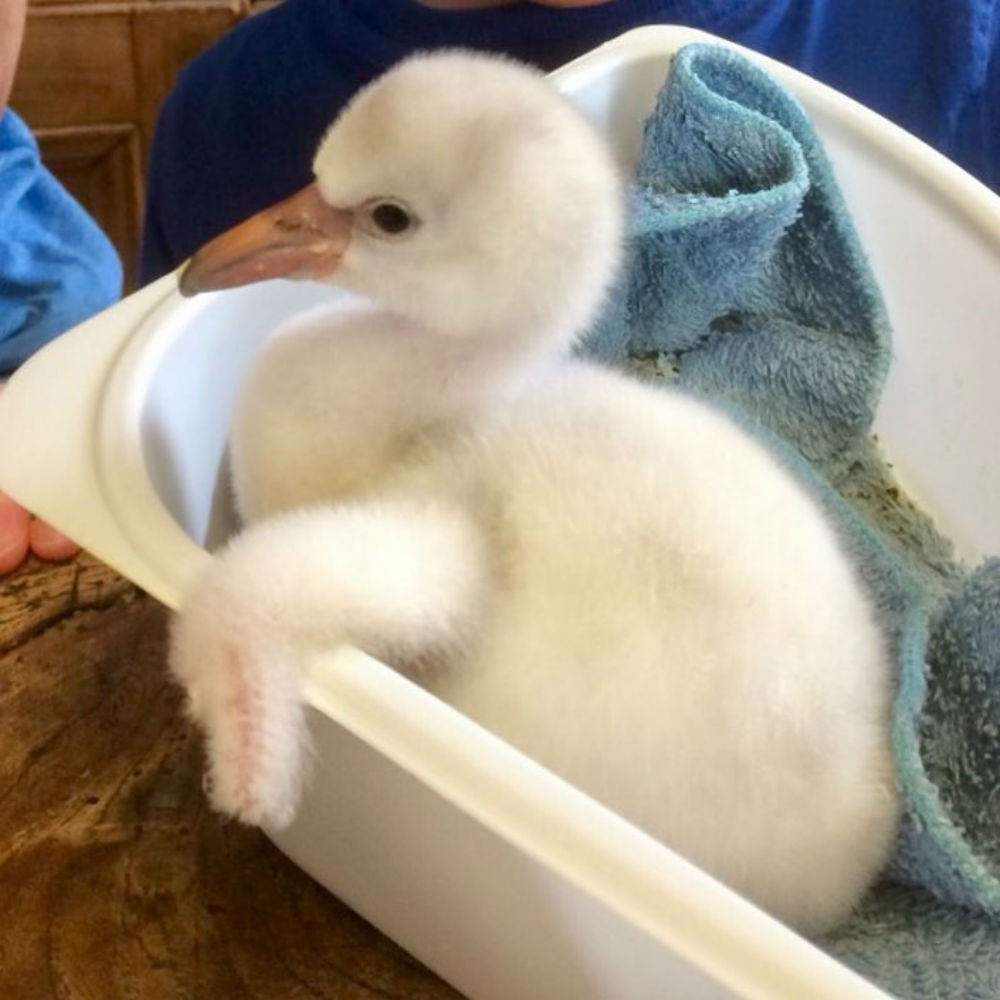ADORABLE images show a flock of newly hatched flamingo chicks being hand reared in Scotland after too many were born at Chester Zoo.
Conservationists Mark Haillay and Owen Joiner saved the chicks from being “thrown out” as the zoo’s own flock is currently full.
The tiny chicks, also known as flaminglings, are being reared and and hand-fed every two hours by the couple near Oxton in the Scottish Borders.
The pair hatched nine chicks bred from spare eggs taken from an established flamingo flock at the zoo in Chester, Cheshire.

The bird-loving duo have been developing Bird Gardens Scotland, a conservation project for rare and endangered birds, for over 10 years.
The Chilean flamingo is currently suffering from a population decline and its conservation status is listed as “near threatened”.
Speaking today, Mark, 51, said: “Chester Zoo had a surplus of around maybe 30 eggs after their recent breeding season, and about four or five years ago they would have simply been thrown out.
“However, Owen had worked hard to establish that they can be hand-reared if they are fed every two hours. It takes a lot of time and effort, staff over time and some facilities don’t have the ability to do that.
“But, as we live on site and the barn they were hatched in is right next to our house – it was a bit easier for us and that’s why Chester Zoo gave us the eggs.”
He added: “It’s incredibly exciting to think these little balls of grey fluff will grow to be majestic flamingos.
“Rearing flaminglings is hard work – it takes the energy of both parent flamingos to rear just one chick. We’re hoping to rear more than ten chicks each year from surplus eggs.
“I also have my business on site, Oxton Pottery, so I will spend most of the day making pots and then take a break to go and feed some flamingos.
“They all have very different personalities already, some are greedy, some are a bit more dopey.
“We tell them apart by the different coloured tags that they have on at the moment, and we haven’t named them yet. We’re going to offer the opportunity to name them for £500, which would take us most of the way there to finishing off the pond and their habitat.”
Although the chicks are currently fluffy and grey, they will change colour once they begin to eat “flamingo food” when they are fully grown.
Mark explained: “Flamingo’s get their colour from their diet – they eat shrimp which feeds on red algae. Commercial flamingo food is made from the same stuff, so they will be pink.
“They will also be able to fly freely, as we won’t be penning them in as some places do.”
Mark and Owen have now began to establish their flamingo flock and have moved them into a special constructed “baby barn”.
Bird Gardens Scotland CIC uploaded a short clip of the fluffy grey chicks moving into their new home yesterday morning.
They wrote: “Flaminglings successfully transferred to the Baby Barn this morning, exploring their new room with a view. The viewing windows give visitors the chance to watch them settle in.”
The footage begins with the nine chicks huddled together and exploring their new home.
The tiny birds peer out of the windows, and as the camera moves upwards a flower filled garden and benches for visitors can be seen.
Gill Pipes wrote: “Well done. Looks great in there. Lucky wee flaminglings.”
Barbara Whittem added: “Lovely.”
Elizabeth Cunningham commented: “Growing so fast. Looking lovely.”
Addison Mccarthy said: “They’re so big.”
Mark, a potter who lives on site, and Owen, a biologist and expert bird breeder, rescued the surplus flamingo eggs from Chester Zoo.
The eggs were kept in an incubator at Chester Zoo, and were then carefully transported to Oxton to hatch.
The nine chicks hatched around two months ago, and since then have been hand-fed with a mixture of fish and egg every two hours.
Now slightly bigger, and fluffier, the grey chicks have moved into a specialised “baby barn” and are being fed around four times a day.
Mark and Owen hope to establish a flock of around 60 birds in the hope that they will become self-sustaining.
Flamingo’s will only breed if they are in a large flock of around 60 birds, and enter into a type of “dance” before they breed.
Mark joked: “The whole flock starts dancing, there’s a little flick of a wing and it gets going. They need a party to get started.”